Click here for a link to complete edited article:
By John P. Hussman, Ph.D. | 27 November 2009
All rights reserved and actively enforced.
Last week, the Mortgage Bankers Association released the most comprehensive report available on third quarter delinquencies. Here is a summary of points from that report:
|
As I noted a couple of weeks ago in The Second Wave Begins, we are now largely beyond the peak of the sub-prime mortgage crisis, and have just begun the second wave of Alt-A and Option-ARM resets. That's important, because what we saw in the third quarter, then, was still part of the relatively tame and predictable March-November 2009 lull in the reset schedule. In that context, the surge in delinquencies and foreclosures on prime fixed-rate loans is disturbing, because that wasn't even part of the reset equation, and represents a relatively pure effect of the weakness in employment conditions.
Now, we face a coupling of those weak employment conditions with a mountain of adjustable resets, on mortgages that have to-date been subject to low teaser rates, interest-only payments, and other 'optional' payment features (hence the "Option" in Option-ARM). These are precisely the mortgages that were written at the height of the housing bubble, and therefore undoubtedly carry the highest loan-to-value ratios.
The inevitability of profound credit losses here is unnervingly similar to the inevitability of profound losses following the dot-com bubble. In that event, it wasn't just that people were excited about dot-com stocks in a way that might or might not have worked out depending on how fast the economy grew. Rather, it was a structural issue that related to the dot-com industry itself— those bubble investments couldn't have worked out in a competitive economy, because market capitalizations were completely out of line with what could possibly be sustained in an industry that had virtually no cost to competitive entry. If you understood how profits evolve in a perfectly competitive market with low product differentiation, you understood that profits would not accrue to the majority of those companies even if the economy and the internet itself grew exponentially.
In the current situation, the assumption that the credit crisis is "behind us" is completely out of line with what possibly could result from the marriage of deep employment losses and an onerous reset schedule on mortgages that have extremely high loan-to-value ratios. A major second wave of mortgage losses isn't a question of whether the economy will post a positive GDP print this quarter or next. Rather, it is a structural feature of the debt market that is baked into the cake because of how the mortgages were designed and issued in the first place.
If one wishes to monitor the markets for emerging signs of risk, several areas are worth watching. First, the FDIC should release its most current Quarterly Banking Profile later this week. That report will be an interesting gauge of emerging credit stress. Yet even here, a lot of the pressure to properly account for losses on off-balance sheet entities and so forth won't start until next year. In the meantime, credit spreads in general, and credit-default swaps on individual companies may bear closer attention in the weeks ahead. Finally, given the enormous pressure there may be to put a good face on increasingly bad assets, the departure of the chief financial officer of at least one major banking institution, which would not surprise me early next year, might be a sign that all hell could break loose.
The past decade has been largely the experience of watching tanks rolling over a hilltop to attack the villagers celebrating below. Repeatedly, one could observe these huge objects rolling over the horizon, with an ominous knowledge that things would not work out well. But repeatedly, nobody cared as long as it looked like there might be a little punch left in the bowl. As a result, long-term investors in the S&P 500 have achieved negative total returns over a full decade. These negative returns, of course, were also predictable at the time, based on our standard methodology of applying a range of terminal multiples to an S&P 500 earnings profile that has— aside from the recent collapse— maintained a well-behaved growth channel for the better part of a century.
From my perspective, we are again at the point where we should be alert for tanks. We already know that stocks are priced to deliver a 10-year total return in the area of 6.1% annually— among the lowest levels observed in history except for the period since the late-1990's (which despite periodic advances has ultimately not worked out well for investors). We are already observing evidence of weak sponsorship from a volume perspective and growing non-confirmations of recent highs from the standpoint of market internals. The cumulative tally of 'surprises' in economic reports (a metric we credit to Bridgewater, which Bill Hester adapted here), has also turned down decidedly. Though the historical correlation is not always as strong as it has been during the recent downturn, shifts in economic surprises have tended to lead market turns in recent years.
Still, with market internals mixed but not clearly collapsing, prices strenuously overbought but still achieving marginal new highs, and valuations unfavorable but not as extreme as they were in 2000 or 2007, investors may be convinced that there is still a little bit of punch in the bowl. We can't argue with that too strongly, and have been trading in (on market weakness) and out (on market strength) of a modest positive market exposure in recent weeks (to diversify our position and allow for two very different potential states of the world). We're just keeping our risk very close to the vest.
In short, we have to allow for the potential for further speculation, and we can't ignore the day-to-day charts showing several market indices near 52-week highs. But we are also at the point where we can look right over the top of the monitor, and see the tanks a-coming.
Market Climate
As noted above, the Market Climate for stocks last week was characterized by unfavorable valuations and mixed market action— with several major indices achieving new 52-week highs, but weak volume sponsorship, lack of confirmation from several indices and market breadth, and still strenuous overbought conditions from an intermediate-term perspective. The Strategic Growth Fund remains largely hedged, though we are allowing for a small amount of positive exposure on weakness, and clipping that exposure on strength. Most of the day-to-day fluctuation in the Fund here is driven by variation in the performance of the stocks owned by the Fund versus the indices (the S&P 500, Russell 2000 and Nasdaq 100) we use to hedge. That fluctuation can be positive or negative day-to-day, but the performance differential from our stock selection has been a net contributor to Fund returns both this year and since inception.
In bonds, the Market Climate last week was characterized by modestly unfavorable yield levels and modestly favorable yield pressures. The Fund made a very distinct move away from TIPS on the strength of recent weeks, as real yields on many issues moved to negative levels. The Fund is also flat foreign currencies, having closed those positions out on recent strength, and has only about 1% of assets in precious metals shares and about 4% of assets in utility shares. The primary risk carried by the Fund currently is a modest amount of interest rate exposure, where the Fund carries an average duration of about 3 years, mostly in intermediate-term Treasury securities. As usual, we tend to be opportunistic in establishing investment positions, so to the extent that we observe decided weakness in foreign currencies, precious metals or TIPS (all of which would most probably be driven by a shift toward risk-aversion in response to fresh credit concerns), I would expect that we would re-establish exposure in these areas. For now, we are maintaining a comfortable but limited amount of interest rate exposure, and are prepared to respond to opportunities as they arise.
… … … … … .
Three Observations on Third Quarter Earnings
Click here for a link to complete article:
By William Hester, CFA | November 2009
All rights reserved and actively enforced.
The bulk of third-quarter earnings are now in. Here are three observations that have been widely discussed: (1) Earnings fell about 15 percent from this time last year, which was better than expected at the beginning of the reporting season. (2) More than 80 percent of companies announced earnings above analyst's expectations, but only about 55 percent of companies beat on revenue expectations. (3) The bulk of the earnings declines were delivered by economically sensitive groups like materials and energy stocks, while the financials posted the largest gains in operating earnings. Here are three more observations which have received less attention: (1) Some amount of investor selectivity or "discretion" is returning to the stock market. (2) Higher quality companies may be staging a comeback. (3) The earnings surprise beat rate may be useful, but not in a way that you might expect.
It's important to recognize that analyst estimates for say, year-ahead earnings, are almost always far too optimistic. As the actual reporting period draws closer, analyst estimates for various companies are gradually cut (as was the case prior to the third quarter reports). So when we say that reported earnings were generally above analyst expectations last quarter, that fact comes with the caveat that those expectations were the whittled-down expectations that existed just before the actual earnings were announced. Of course, the other caveat is that an earnings report qualifies as an upward surprise even if it surpasses analyst expectations by just a penny, which is common. For that reason, the average earnings surprise or disappointment prompts the market to reward or punish the stock price only by something on the order of 2% or less over a given quarter.
Before talking about the comeback of investor discretion, it's important to take a quick look at one example of investors' lack of discretion earlier this year. As the market moved higher this year, some observers claimed that companies were reporting results that were better than expected, and these results were fueling the stock-market recovery. But when you look at the data, this argument isn't persuasive.
The bar chart below shows the average net performance of stocks in different groups. The three bars on the top show the net performance of stocks that reported negative surprises in both earnings and sales, and then in earnings and in sales, each. The three bars on the bottom show the net performance of stocks using the same metrics, but include only those that surpassed estimates. The return periods run between each company's reporting dates. So, for example, Alcoa's returns run from July 8th through October 7th of this year, following the company's second-quarter report. The returns are market adjusted (versus the return of the S&P 500 equal-weighted index), and then averaged. Generating returns in this way allows us to focus on what investors are responding to on a company-by-company basis in the periods following the release of new information.
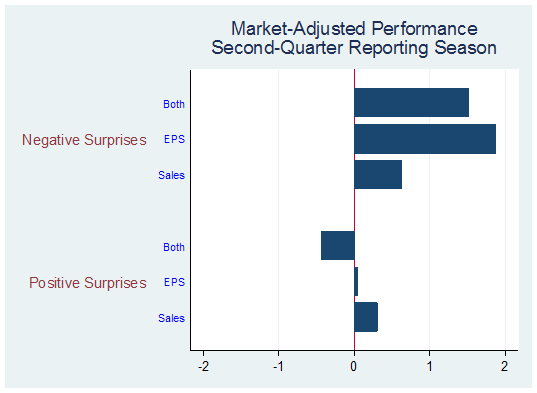
Although top-line sales growth is getting more attention recently, typically investors are more sensitive to earnings surprises. And as the graph above shows, investors did respond to earnings, just not in the way that is typical. Companies that announce earnings surprises tend to outperform companies that miss estimates, on average. But during the second quarter reporting season, that trend was mostly reversed. Companies that missed estimates performed best. And although it's not shown, the performance during the first quarter reporting season was similar, especially in regard to earnings surprises. Companies that announced positive surprises trailed the market by about 2 percentage points, on average. Those companies that missed estimates outperformed the market by about 2 percentage points.
The next chart updates the performance of stocks during the third-quarter earnings reporting season. Here, company performance was measured from the company's most recent earnings announcement date through Friday. You can see that there are some signs that discretion is coming back into the market. Companies that reported positive surprises have outperformed the market— and the better the news, the better the performance has been. Companies that reported positive earnings surprises are doing better than companies that reported only positive sales surprises. And companies that have reported better-than-expected results in both measures have outperformed companies that surprised on just one metric.
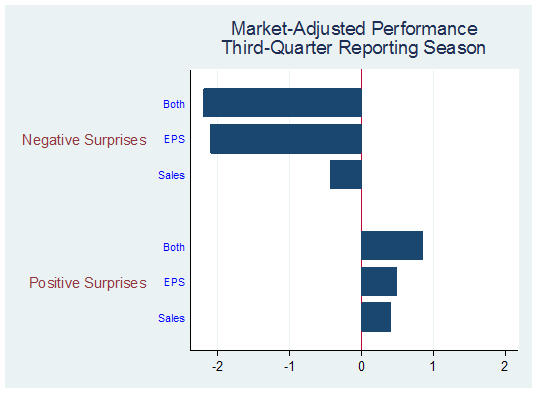
The rally up through late summer was less about improving corporate performance than it was about reversion to the mean and beta chasing. Investors mostly indiscriminately bought highly cyclical and highly levered stocks, partly because some of these stocks were priced for potential bankruptcy and partly based on the view that the economy will recover strongly next year. More recently, investors are showing a bit more discretion, by seeking out companies that are producing sales and earnings surprises in a very challenging economic environment.
A Turn for High Quality Stocks?
The beta-chasing pursued by investors this year created stark differences in the performance among individual stocks. One of the clearest places to see this was the difference in performance between lower-ranked companies based on measures of quality (mostly the dependability of operating results) and higher-ranked companies. High-quality companies have returned about half what the equal-weighted S&P 500 Index has returned this year while the very lowest quality companies have returned almost 2.5 times the index. As other analysts such as Jeremy Grantham and Mark Hulbert have pointed out, this relative difference in performance of the two groups is off the charts when you compare it to similar market rebounds in the past.
There may be a shift taking place. Since the beginning of the third-quarter earnings reporting season the average high quality stock has returned 7.5 percent, versus 6.4 percent and 5.9 percent, for mid-quality and lower-quality stocks, respectively. Now, that's just a blip on the relative performance graph compared to the extent that low quality has outperformed this year. But it's worth noting because if investors are being more sensitive to actual company operating performance, then the trend in relative performance between high and low quality companies may continue. The graph below shows the rate at which companies beat their third-quarter earnings estimates based on S&P's quality rating. Nearly 90 percent of higher quality companies beat their earnings estimates, while only about 60 percent of low quality companies beat their earnings estimates. If economic and earnings growth over the next few quarters turns out to be lumpier than is currently forecasted, then high quality companies will likely be in a better position to produce more favorable results versus expectations. If investors continue to show discretion in choosing companies with favorable operating performance relative to expectations, this would benefit higher quality companies.
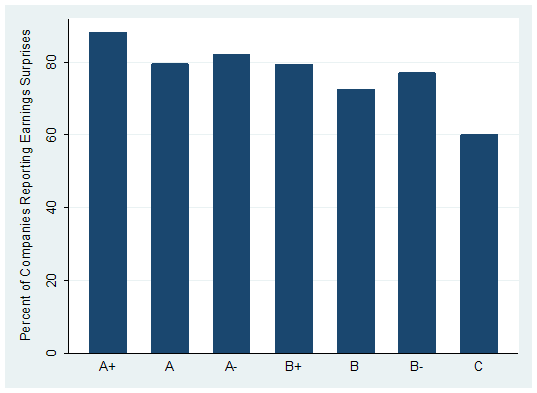
Beat Rates
About 80 percent of the companies reporting earnings in the third quarter beat analyst's estimates. That's a record, according to Bloomberg's record keeping of positive earnings surprises, which began in 1993. We'll use this data to attempt to answer a couple of important questions. Is there value in tracking the earnings surprise rate? Can investors expect the market to move higher when the surprise rate rises? Is there information in a declining earnings surprise rate?
The graph below shows the Positive Earnings Surprise Rate for the S&P 500 Index going back to 1993, using monthly data. As you can see, there has been a secular rise in the surprise rate. Over time companies have caught on that investors prefer positive surprises to negative surprises. That may be part of the reason for "one penny" earnings beats, which are relatively common. The tendency for analysts to lower earnings expectations as the actual reporting quarter approaches is another contributor to the general secular rise in the beat rate. If these practices continue, at some point we'll need to drop the word 'surprise' from the earnings surprise moniker.
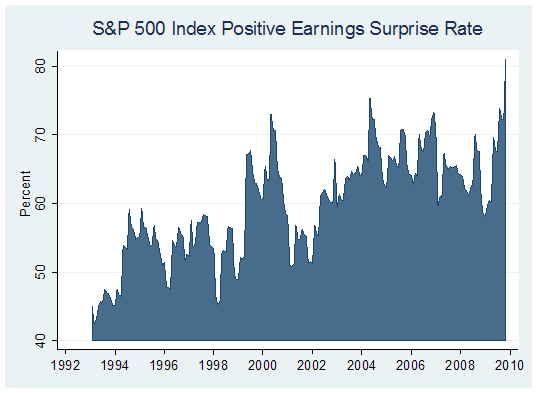
But until then, and considering that the earnings surprise beat rate has become so widely followed— and often used as bullish argument— it's worth looking at whether it's a valuable indicator. Often the clearest way to see if an indicator is useful is to test it as if it were a trading strategy. When this is done with the earnings surprise line you get very mixed results. As you can see by the graph above, absolute levels don't work since the index has drifted up over the 15-year period. Information gleaned from simple look-back strategies is also mostly unhelpful. The graph below plots the return of a strategy where you invest in the market when the surprise line rises from the previous month, while earning the risk-free rate during periods where the surprise line fell from the prior period.
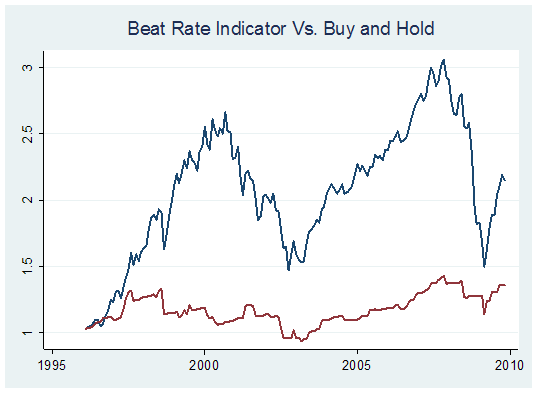
It's clear that the level and short term increases and decreases in the surprise rate aren't particularly useful. This is partly because the beat rate data is fairly volatile from month to month. Even so, we can ask a slightly different question.
Given that the earnings beat rate seems to have moved up gradually over time, what happens when— despite this trend— companies fall short of the recent trend, either by a significant amount or over an extended period of time? We can pick up either pronounced or sustained disappointments in the beat rate by taking a 12-month moving average of the beat rate and comparing it to the 24-month moving average. The red line in the chart below shows the investment return from avoiding periods when that 12-month average fell short of the 24-month average.
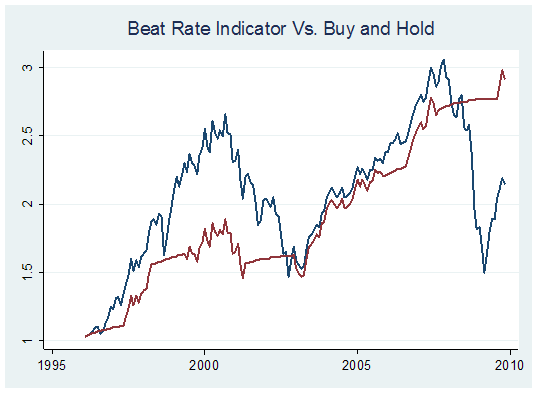
Since the beat rate has generally trended up over time, the 12-month average has generally been above the 24-month average, so this version of the indicator has the tendency to stay invested. As you can see, the earnings surprise rate was above its moving average during a portion of the late 1990's rally and the bulk of the 2003 to 2007 rally. But what is most impressive is how much of the market's losses coincided with the surprise rate falling below its moving average, which happened convincingly in 2001 and again in 2007. By avoiding market risk when earnings surprises fell below their 24-month moving average, the maximum drawdown using this simple metric was only about half of what a buy-and-hold strategy experienced.
So, the surprise rate is mostly ineffective when measured on an absolute level and also when used with shorter-term comparisons. But there may be some information in significant or sustained failures of the beat rate to keep up with its recent history (e.g. its 24-month average). With the current beat rate at a record high, the current rate may be difficult to sustain in the months ahead (based on typical past trends). Investors may want to watch the rate of that descent.
Here are a few important caveats. While disappointments in the beat rate are important, this indicator leaves out too much information to be used as the sole determinant of an investment position. There's no valuation component, no market action or price trend measures, data availability is mostly limited to two bear markets induced by dramatic profit recessions, and it wasn't tested in a way that an investment model should be tested (split samples with a holdout data set).
While the indicator turned down before the major losses of the most recent bear market, it didn't turn negative in the 2000-2002 bear market until about half of the losses were already sustained. Even so, since the surprise rate is an indicator that has gained in popularity, it is worth highlighting its strengths. The primary strength of the indicator, based on available data, is that becoming more defensive when the surprise rate is declining rapidly may be helpful in mitigating risk.
No comments:
Post a Comment